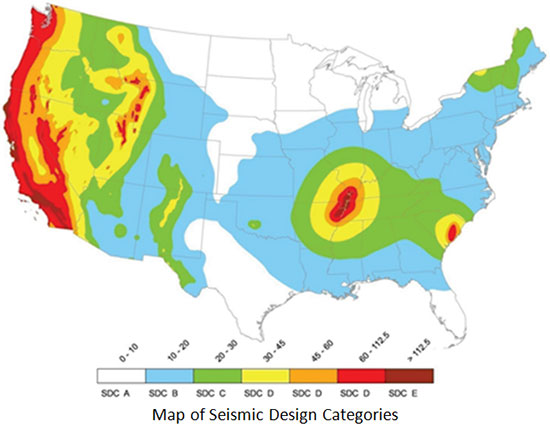
How and Why You Should Factor Seismic Events into Your Pallet Rack and Warehouse Design
The importance of seismic considerations in pallet rack system design cannot be overstated. We often think of earthquakes as rare phenomena; however, data from the United States Geological Survey indicates that there are approximately 55 per day on average, 16 per year of which can be described as “major events”.
At the same time, we’re experiencing an increase in the detection of seismic activity, there is also an increase in the number of bulk warehouse storage facilities, and a corresponding increase in pallet rack system installations for retail, e-commerce, automotive, grocery and other industry uses.
What’s the connection? Many of these warehouses are being opened in areas with heavy seismic activity. While these regions are primarily on the West Coast, areas throughout the country are vulnerable to at least minor earthquakes. Systems that are not built to withstand these incidents put your property, your employees, and your customers in substantial danger, including injury from falling items, destruction of materials and adjacent racks, and more.
The Federal Emergency Management Agency (FEMA) issued a comprehensive report on the importance of properly configured pallet racking systems in seismic regions in 2005. Since then, the Rack Manufacturers Institute (RMI) and the National Building Code (NBC) has mandated all pallet rack systems in warehouses in seismic areas are built to handle earthquakes; however, it helps to go above and beyond, taking extra measures to ensure maximum preparation.
Ensuring Maximum Seismic Readiness of Your Pallet Rack System

Earthquake-ready pallet rack systems must be made of heavier materials and/or a more robust design versus those built for areas with no to low seismic activity. There are certain design variables for pallet rack systems, based upon the amount of seismic activity in a designated area. Some of the primary considerations for seismic pallet rack design include:
- Geography – The location of your facility will determine its level of vulnerability to a high-impact seismic event. High-risk seismic areas are identified in the image above, provided by RMI’s Specification for the Design, Testing and Utilization of Industrial Steel Storage Racks. Another geographical consideration in determining whether or not the subsoil and building floor are adequate to support your pallet rack system.
- Daily Ground Movement – Professional engineers can assess how much the ground will shift per day on average, depending on the warehouse or storage facility location. These insights can help you determine how much distance you should place between each rack, and how far away your racks should be from high-traffic areas.
- Weight of Average Rack Loads – The weight of average rack load is critical to calculating down-aisle force. Most warehouses are built to house high-density loads in tighter areas. Calculating down-aisle force (the force with which collapsing racks impact adjacent fixtures) is critical to mitigating impact and minimizing serious damage.
 Materials and Construction – Pallet rack systems in high-impact areas require a heavier-gauge steel and stronger components, specifically thicker and larger baseplates for anchoring the rack to the floor. Baseplates should fall between 5 X 5 and 6 X 8 inches in size, and between 0.25- to 0.375 inches in thickness. Bolted systems generally provide more strength and durability, as opposed to welded systems.
Materials and Construction – Pallet rack systems in high-impact areas require a heavier-gauge steel and stronger components, specifically thicker and larger baseplates for anchoring the rack to the floor. Baseplates should fall between 5 X 5 and 6 X 8 inches in size, and between 0.25- to 0.375 inches in thickness. Bolted systems generally provide more strength and durability, as opposed to welded systems.
To further protect your system against high-impact seismic events, consider using heavier or specially designed frame-bracing panels and larger beam connectors for added support. It’s also critical to implement adequate beam sizing and placement, as lack of lower-level support can increase movement during seismic events.
Apex Warehouse Systems delivers high-performance, custom storage solutions that fully consider your facility’s level of seismic vulnerability. We have been helping warehouses and storage facility operators in high-seismic areas safeguard themselves against damage for years. Call our expert team for more information.
For more information on FEMA & RMI Seismic Considerations for pallet rack safety, check out these helpful resources:
FEMA: Seismic Considerations for Steel Storage Racks Located in Areas Accessible to the Public

